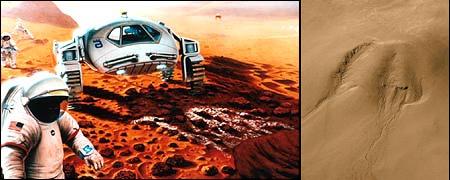Mars has all the necessary conditions to support life
On the right: channels on Mars in which water apparently flowed in the recent geological past; On the left - a future expedition to Mars. Illustration - NASA
If the water in the glaciers hidden on Mars below the surface melts, it will create an ankle-deep sea across the entire planet, if it were flat, the scientists say. The latest findings from the Mars Odyssey spacecraft currently orbiting the Red Planet were announced at the annual meeting of the American Association for the Advancement of Science (AAAS) in Denver, Colorado.
The instruments on the spacecraft observe the Martian soil for nearly a year. The data collected allowed the researchers to complete the first global map where hydrogen (a seal of water) is hidden just below the surface.
"It is now clear that there is enough water on Mars to satisfy the needs of a manned expedition," says Bill Friedman, whose lab in Los Alamos operates a neutron spectrometer on Odyssey.
In fact, there's enough water to cover the planet in water 13 centimeters deep, and we've only studied the near-surface layer.
The map shows that from the 55th latitude to the poles, Mars has large reservoirs of rocks filled with water ice, sometimes the water makes up to 50 percent of their mass. In other words, one kilogram of soil may contain up to half a kilogram if it were baked in an oven for example by astronauts who need water to maintain themselves while on Mars.
The Los Alamos instrument detects neutrons produced when cosmic rays collide with atoms in the Martian soil. Different atoms produce neutrons with specific characteristics.
By looking at the signature of hydrogen, the main component of water molecules, Odyssey can trace the presence of water concentration near the poles and the hydric minerals at low latitudes. These are exciting times for Martian explorers. There are good indications that, on rare occasions, water flows on the surface of the planets.
The Mars Global Surveyor, which orbits Mars much further than the Odyssey, discovered what appeared to be channels and river valleys. All the data supports the theory that the surface of Mars was once much wetter and warmer than today. Dr. Maria Zuber from MIT says: "Humans don't begin to think that maybe there was twice as much water on Mars as was captured on Earth, it's exciting."
Investigators have yet to satisfactorily explain where the water went. If many of them now appear as underground glaciers, work will be needed to understand how they got there.
Prof. Bruce Jakoski from the University of Colorado said at the AAAS conference: Mars meets all the environmental requirements to support life: flowing water, availability of all the materials needed to build life and an energy source that can be used to support metabolism. This does not prove that there is life on Mars, but only the possibility that it is not a stupid idea and it is worth going out and checking. The US and European space agencies plan to launch landers to the Red Planet during 2003.

